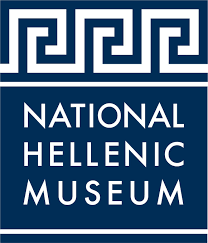Metaphysical landscapes by polymath John Fotiadis exhibited at National Hellenic Museum. Architect, artist, musician touches on sacred geometry, symmetry, the substrate of our 3D frame, atomists, resonance, teleology, ontology, more
By Terry Poulos, Scientiquity founder

[CHICAGO, IL, USA 6/19/2023] In physics, the Principle of Least Action informs of nature’s wont of efficiency, that systems tend toward expending the least amount of energy necessary to perform a given task. It’s nature’s elegance through simplicity, now believed to transcend all the universe from quantum to classical scales.
Greek American architect, artist, and musician John “Yanni” Fotiadis embodies that principle in designing buildings and landscapes, in creating art, and music. In “Beyond Antiquity,” a series of nearly 40 pieces on exhibit this Summer at the National Hellenic Museum in Chicago, Fotiadis takes us on a tour-de-force of clean, pure, radiant, and brilliant metaphysical landscapes, a hybrid of ancient-to-modern blended images from classical antiquity to present day.
The artist mixes raw hand-drawn art with cutting-edge multimedia and computer-assisted image creation to present magnificent archaeological ruins, Platonic and Archimedean solids, and modern-day landscapes in a seamless optical feast reaching beyond the surface to evoke a visceral mind’s eye subconscious reaction.
Fotiadis “explores classical antiquity in Greece and takes us into the present and future via the same subjects: architecture, myth and landscape,” reads the museum’s summary. “Classical antiquity is omnipresent in Greece, where you can glance up from a cosmopolitan street in Athens and see the 2500-year-old Parthenon. The ancient past is woven into the cultural legacy of the country physically, psychologically, intellectually and emotionally. It is an immense, epic and unavoidable presence that inspires all of Fotiadis’ art,” concludes the promotional message.
“It is no coincidence philosophy was born in this part of the world…The natural environment of Greece is an environment ripe for expanding thinking…”
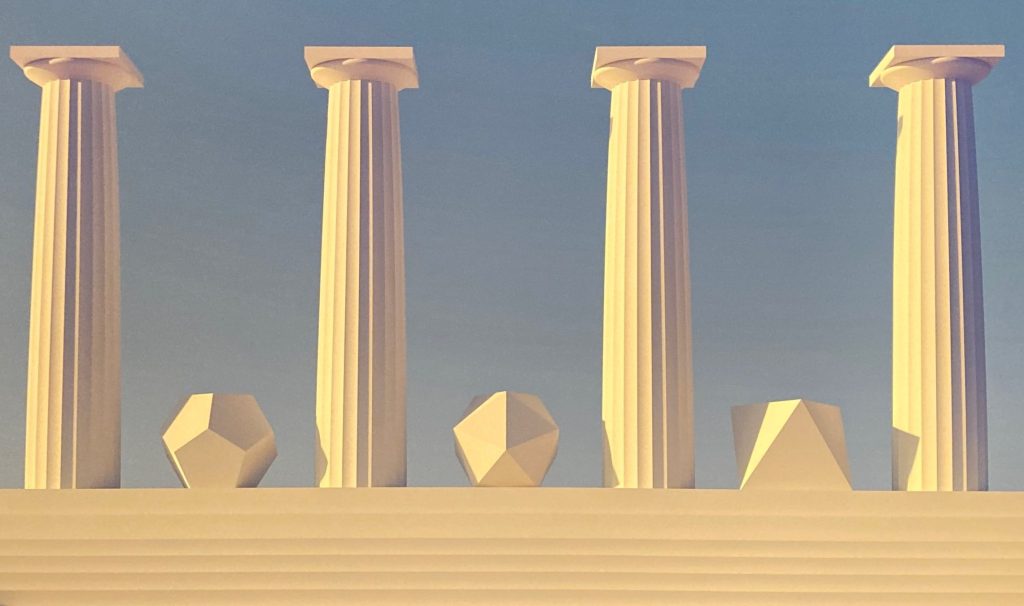
“It is no coincidence philosophy was born in this part of the world,” wrote Fotiadis, who currently resides in New Jersey in the greater expanded Manhattan region. “The natural environment of Greece is an environment ripe for expanded thinking…Creating these artworks has taught me that one can find the ‘divine’ in anything, even the most banal object, under the right conditions and if one looks hard enough. I find myself returning again and again to the bottomless well that is ancient Greece.”
We spoke with Fotiadis, who’s a polymath not only with his hands and geometric perspective, but also has a firm grasp of philosophy and history. The topic of artificial intelligence came up. Fotiadis has been experimenting with the program Midjourney and other 3D design software to further blend and expand his artistic toolbox. But he also recognizes we’re in the midst of a great technological explosion and disruptive Renaissance.
“To look ahead, to survive, I believe we must examine and learn from the past. I feel that is the only way we will move beyond antiquity, and beyond our present state, towards a better future.”
“Now more than ever,” he explained, “as we face a rapidly changing and virtually unrecognizable, technologically driven world, I find it a source of comfort, reassurance, guidance and most of all, knowledge and wisdom. To look ahead, to survive, I believe we must examine and learn from the past. I feel that is the only way we will move beyond antiquity, and beyond our present state, towards a better future.”
Fotiadis, as delineated in the museum’s literature, labels his latest creations “Metaphysical Landscapes, a collection of digital images that show imaginary environments inhabited by Platonic solids and classical architectural forms, arranged in such a way as to capture or speak to the transcendence that is evoked when Greek architecture, deliberately placed in the landscape, begins to resonate with its surroundings.”
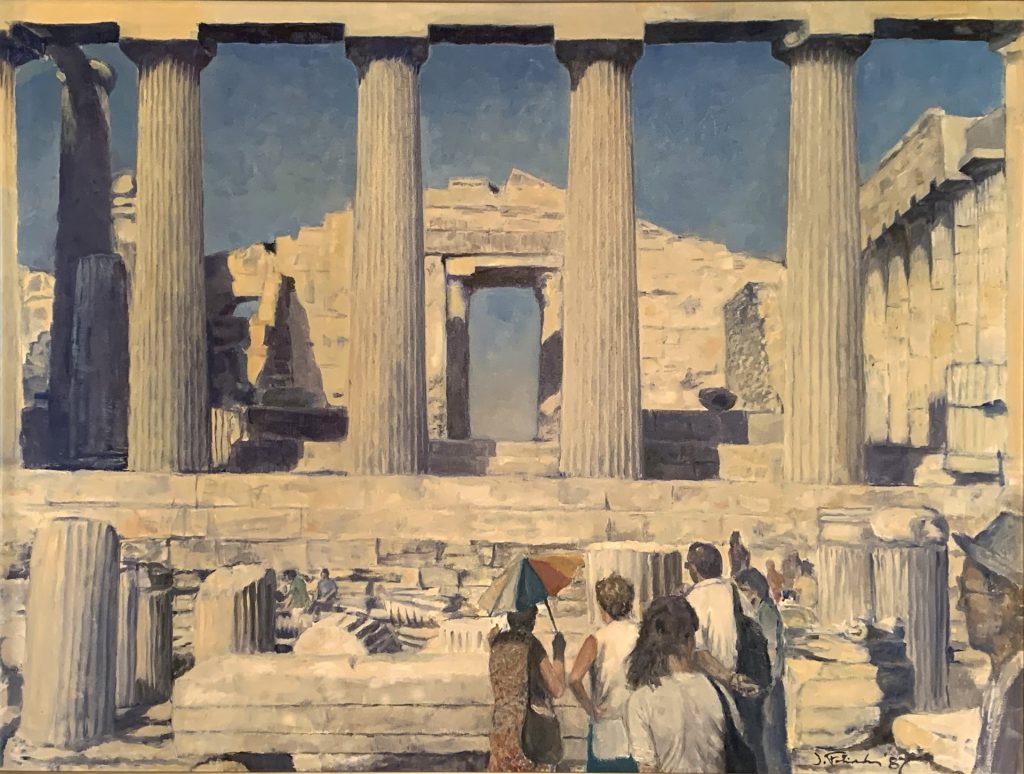
Fotiadis studied architecture at Temple University and Columbia University, earning a Master’s degree. In a 30-year architectural career, he has designed projects for clients in Doha, Seoul, Dhaka, San Francisco, Cairo, Moscow, Panama, Kyiv, Tbilisi, Athens, Dubai, and Istanbul. This has afforded him a global perspective on optics, architecture, philosophy, culture and art.
Like most artists (and scientists), Fotiadis keeps a notebook of esoteric sketches combined with life-like images and notes and observations. His latest codex began in 2019 with a series called “The Solace of Antiquity.” He works with graphite, colored pencil and charcoal to “document the ruins of ancient sites, and explore the effects of the luminous Aegean light on the architectural remnants there,” writes Fotiadis.
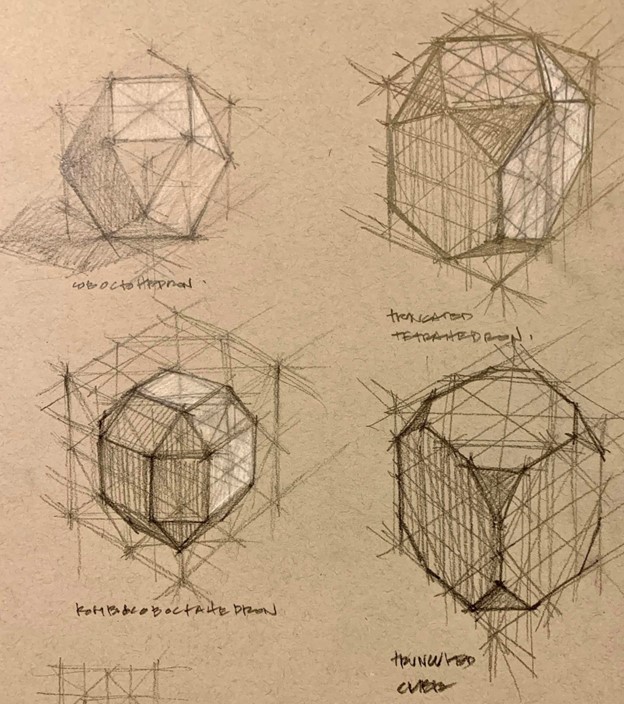
“I also became a bit obsessed with one of (artist) M.C. Escher’s solids – a compounded form of 3 octahedrons. This form like so many other Archimedean solids, is derived from a cube,” he explains. “I smiled to myself when I saw the `CH4′ in one of the sketches next to the tetrahedral-shaped form which I remembered from chemistry as also being the shape of the methane molecule. The idea of an order that underlies the universe and which is most clearly evidenced through the study of mathematics, is an idea that goes all the way back to Pythagoras.”
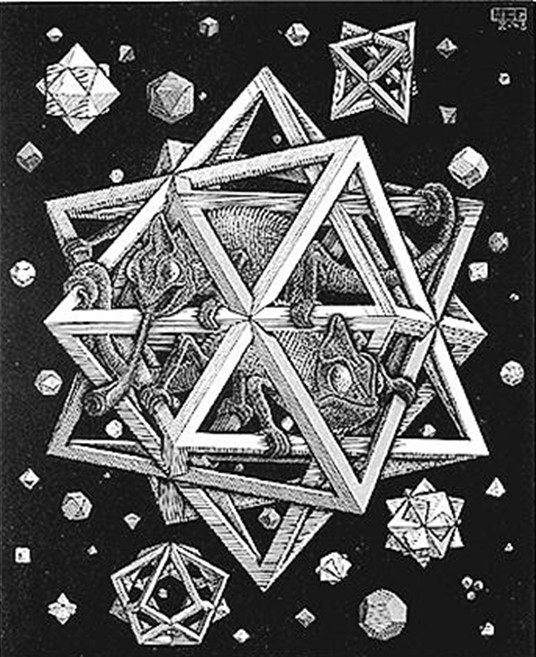
While the Platonists were into Form and pure geometry, the Pythagoreans by some bit of contrast were more students of the `music of the spheres,’ believing all things to be number, and that the universe was itself made of vibrating strands. While playing the ancient Greek stringed instrument called the Lyre, this cult of mathematics discerned that certain notes – a third, a fifth, etc. – were most pleasing and in resonance with the human ear. They considered these ratios to be sacred and that matter itself were comprised of vibrations of such elements, foreshadowing modern-day string theory.
And what does Fotiadis do in his spare time for fun? He’s a singer and guitarist in a rock band. Even the great Leonardo da Vinci couldn’t top that bit of `polymathical’ resonance.
On that “note,” we move to our Q&A portion of the interview, where we cover ground from architecture to geometry to quantum particles, philosophy, harmonic resonance, ontology, and more.
_______________________________________________
SCIENTIQUITY How do you balance elegance through simplicity in architecture and art with the wont of being creative and conjuring up new, unique designs? How do you, as an architect, push the envelope while simultaneously maintaining integrity and utility of structures?
FOTIADIS Regardless of the design problem, I always remember a phrase I learned in Italy years ago – “sempre elegante” (always elegant). That is, regardless of the task at hand, remembering basic compositional principles of harmony, balance, proportion, etc. and keeping those top of mind when I design – be it a new artwork or a building, will go a long way. I’ve never believed in the idea of making something deliberately ugly for the purposes of some subversive narrative or subtext which you see of a lot in art today.
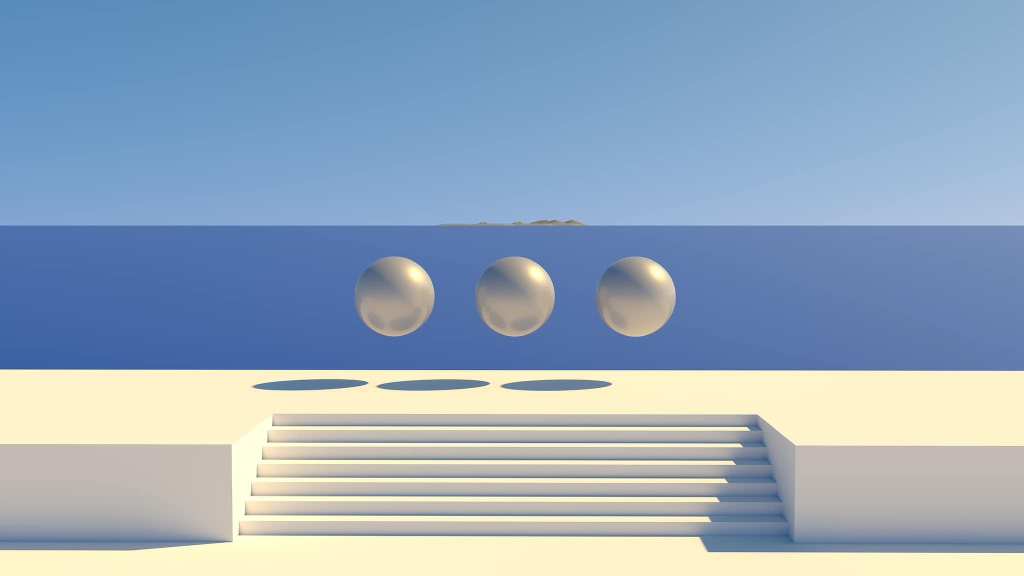
SCIENTIQUITY Each client has their own tastes and needs. Can you point to a cultural preference among the many clients you’ve worked for in terms of simplicity and complexity and more fine detail? Some like perfectly symmetric repeating patterns, some like intricate, weaving patterns which might be more abstract and asymmetric.
FOTIADIS Most clients I’ve dealt with come to the table with a predetermined image in their mind. Since the advent of the internet, clients have access to millions of images which they find appealing, trendy, fashionable, etc., but without really understanding the context from which that imagery is taken and why it looks the way it does. You can’t design a Mediterranean villa in a cold climate. I suppose you can, but you won’t get much use out of it most of the year. I can no longer identify cultural preferences because to a large degree in the world of design – culture, like national sovereignty, is slowly being eroded. To be honest, most of the clients I’ve dealt with were corporate. Primarily real estate developers. They are driven by what the market is demanding. The challenge working with them is always striking a balance between their economic goals, while simultaneously meeting their desire for a striking image for their project – intended to make an impression or reinforce a brand identity. One of the reasons I stopped working as a practicing architect and now only provide consulting services, is due to the fact most clients wanted me to give them a copy of something they had seen. Very few asked me to solve a design problem and provide an innovative solution.
SCIENTIQUITY To your own taste, which is more beautiful: Perfect symmetry, or slightly asymmetric locally but symmetric globally? Or chaos and randomness? I’d think that wouldn’t fly too much with building design.
FOTIADIS It depends on the subject and context. An idea like symmetry conveys other deep ideas such as order, balance, logic. Personally, I find ideas expressed visually in this manner comforting. But sometimes the function of a building or form may not be symmetrical due to its purpose. This is an idea that has been at the core of modernism since its inception. That is, the idea of an honest expression within the design which may not result in an order clear configuration (such as a symmetrical façade for an asymmetrical building behind it). Like everything else, I think one needs to strike a balance.
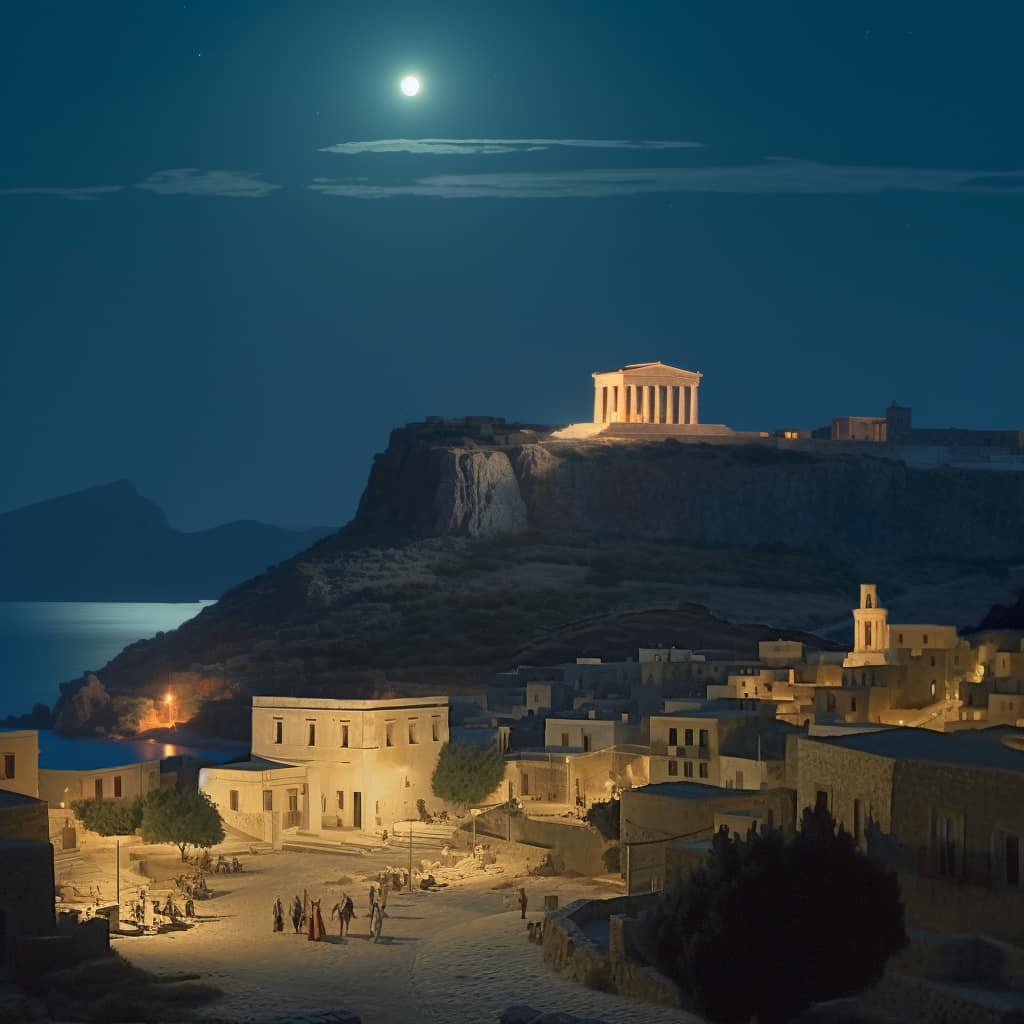
SCIENTIQUITY Who’s your favorite ancient Greek scientist, mathematician, and/or philosopher and why? Your work could be interpreted as a hybrid of Plato, Euclid and Archimedes.
FOTIADIS I have many favorites for different reasons. But In the final analysis it is Plato. Followed by Aristotle. Between the two of them they went very far in positing the true nature of the cosmos and humanity’s place in it. Their achievement is superhuman, absolutely staggering and unprecedented. Every philosopher and scientist who has followed since has followed in their wake. Their importance to the core understanding of humanity itself and the universe cannot be overstated.
SCIENTIQUITY Plato’s forms are ideals. We now know that, as you get smaller and smaller on the quantum scale, things tend to get more rough, or course grained. The ancient Greek atomists thought matter to be comprised of an array of bit-sized, discreet points.
FOTIADIS The Greek word “atom” literally meant that which can no longer be divided or cut into smaller components. In other words, a finite object or point. But from my understanding of physics, that point has not been reached as science continues to discover smaller and smaller components of matter. That in turn raises an ontological and philosophical question as to whether there is a finite point. It seems the universe works in scalar fashion in the opposite direction as well. Is it infinite? Is spacetime infinite? Can something always be, that is, exist without beginning or end? I don’t have the answer but I am beginning to think the reason why I don’t is because we as a species do not have the intellectual capacity to truly understand the authentic nature of “reality,” even if it were revealed to us. We call reality that which we can observe or theorize about (which in turn is also based on empirical observation). But one must ask, what about all that we CANNOT observe? Plato seized upon the idea of flawless beautiful geometric forms which are so perfect that one might speculate they were not invented but rather, discovered, and have always existed. The same can be said of mathematics.
SCIENTIQUITY What does your intuition say? Is the substrate smooth or granular or a bit of both?
“…an omnipresent energy which could be construed as “consciousness” and vice versa depending on the density that consciousness may manifest into physical matter.”
FOTIADIS My intuition tells me that at that scale we are talking about, there exists an omnipresent energy which could be construed as “consciousness” and vice versa depending on the density that consciousness may manifest into physical matter. The answer, probably, is all of the above.
SCIENTIQUITY Is geometry the “stuff” we are made of, or more a product and consequence of an underlying ever more fundamental reality? Or a bit of both? Everything acting together in cohesion, or as they say holism.
FOTIADIS I suspect that like mathematics, geometry is not an invention. Rather it is a discovery. It has its own autonomous rules and logic. To me it represents a much more fundamental aspect of reality of which humanity has only just begun to understand.
SCIENTIQUITY Is reality point-like, or is it diffuse and blurred? Overlapped and entangled as in the quantum scale, or binary and predictable and “each thing its own” like the zeros and ones of a computer?
FOTIADIS Physics has implied via very crude experiments, that on a quantum level parallel and simultaneous realities might exist. Perhaps it is our limited perception that forces us to consider reality as a linear phenomenon, indelibly connected to time and linear in nature.
SCIENTIQUITY The jury is out still. Einstein said he could never abide a universe which did not follow some rules of cause and effect, ergo predictability, ergo elegance and structure or order.
“There is a teleological aspect to this idea which makes sense. The Gnostic and Neoplatonist philosophers believed in an aspect of the same phenomenon operating at different scales – “As above, so below”. I tend to agree and believe that there is a broad and underlying purpose and logic to existence, and therefore reality.”
FOTIADIS It was Aristotle who posited a reality as having “purpose”, in that everything in existence is operating to reach its full potential. This was based on his empirical observations of the natural world. There is a teleological aspect to this idea which makes sense. The Gnostic and Neoplatonist philosophers believed in an aspect of the same phenomenon operating at different scales – “As above, so below”. I tend to agree and believe that there is a broad and underlying purpose and logic to existence, and therefore reality. What that is, however, is beyond me.
SCIENTIQUITY String theory, today’s most widely studied so-called `theory of everything’ and theory of fundamental particles and quantum gravity, may have been foreshadowed by the Pythagorans, whose motto was “all is number.” They believed certain numbers, primes, to be the building blocks, and that certain numbers and sequences as an integral vibrated together to form the structure we experience in our 3D classical spacial frame. They studied this using stringed musical instruments. As a musician and geometer, what is your take? Does your intuition say our 3D classical frame is merely the full-scale rendering of a 2D more linear surface projection, or is the 3D spacial reality fundamental on all levels?
FOTIADIS All IS number. I agree with Pythagoras (as I suspect, did Plato), because numbers have an impenetrable and incorruptible truth and elegance as to how they operate. An absolute undeniable truth. I believe Mathematics is the language of the universe, the language of existence. While we tend to reflexively believe we inhabit a three-dimensional world – perceiving space around us – I believe that we inhabit at least 4 dimensions – if one factors in time. Our frame might be a rendering of something far more complex once one is willing to think of time as a non-linear unidirectional phenomenon.
“…our physical bodies and all the senses that come with them, are largely the evolutionary product of existing on this planet – with its very specific gravity and densities of matter, which in turn shaped our senses and abilities to perceive”
SCIENTIQUITY What is it about ratios such as 1/3 and 1/5 which when struck on a chord, produce such pleasant sounds to the human ear? Are we “fine-tuned” to the resonance of earth at least, and the larger universe also?
FOTIADIS I believe – aside from our consciousness which I have come to believe is separate from our physical being – that our physical bodies and all the senses that come with them, are largely the evolutionary product of existing on this planet – with its very specific gravity and densities of matter, which in turn shaped our senses and abilities to perceive. The foundation of all music (at least in the west) is rooted in chord voicings that include the third and the fifth notes on the scale. Together with the first note they comprise a triad, which in the world of geometry and mathematics could be represented by triangular or tetrahedral forms. Three sided, equidistant, equal angles, equal lengths, etc. forming the foundations of new whole forms which we have come to understand are inherently stable. The human species perceives these intervals of notes as resonant, NOT dissonant. Whether they are that way in the rest of the universe is unknown.
SCIENTIQUITY You mentioned how looking to the past grounds us, so to speak, and maybe prepares us for the innovation of the future. Tell us how AI is wowing you, frustrating you, scaring you, and helping your art and architecture work as well.
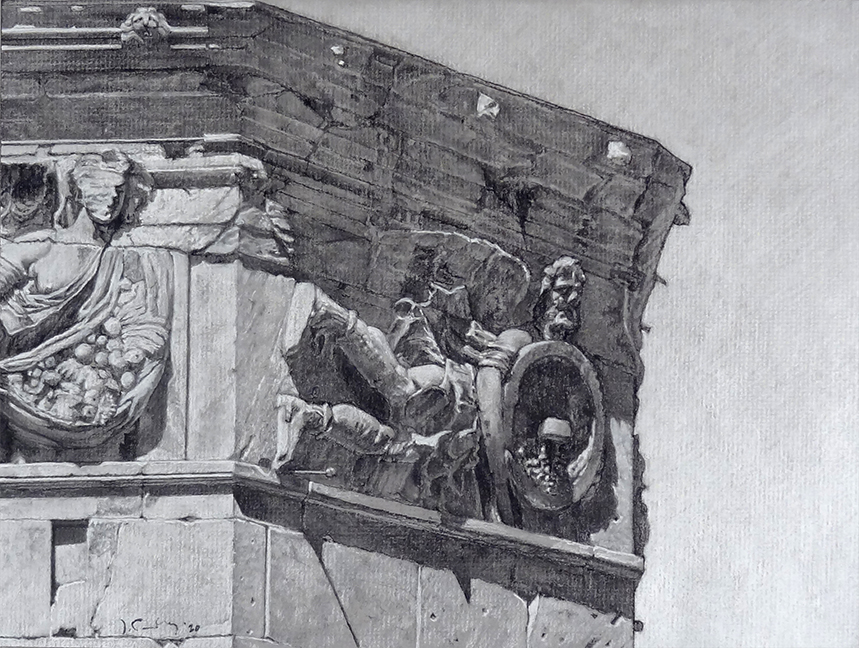
2020. Credit: John Fotiadis
FOTIADIS I’ve been immersed in AI for the past month, experimenting with primarily visual AI engines like Midjouney. At its core it seems to be an incredibly powerful amalgamation of algorithms and data sets, that combined can create compelling (but albeit inaccurate) visual imagery. I have seen AI’s limitations (for now). But I suspect that as it continues to develop, the inaccuracies will become more finite until they are eliminated altogether. To understand artificial intelligence, one must first understand intelligence. And that is the intellectual capacity we have in order to absorb a bombardment of information in the form of images, sounds, sensations, etc, and order that place data into cohesive sets and thoughts that in turn create an armature of reality in our minds that we perceive and experience. Soon AI will reach a point where it will create images and experiences which will no longer be distinct from reality. That in turn will force us all to question what reality really is. Is it simply our perception? Is the reality we inhabit simply one of MANY realities? The ancient Greeks pondered reality and posited a number of different approaches to understanding its essence. I take comfort in knowing that the same ontological questions that keep me awake at night when the rest of the world is sleeping, are the same ones that went through the minds of men two and half thousand years ago in the Eastern Mediterranean.
SCIENTIQUITY Tell us about cubes, a fascination of yours. For instance, they can be reduced to six square sides, and each of those can be reduced to two right triangles. Are cubes as fundamental as right triangles, or are the right triangles the building blocks of cubes?
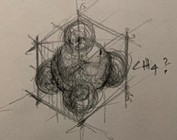
FOTIADIS To me the cube is an excellent starting point. In “Timaeus”, Plato calls it the element of Earth. It is inherently a 3-dimensional volume, not a 2-dimensional form like a right triangle – almost a different geometric species – but nevertheless related. As such the cube immediately becomes the starting point of many different bilaterally symmetrical three dimensional permutations in three dimensional space. The forms which we perceive on a daily basis in our physical world. I’ll spend evenings drawing a cube over and over and seeing what I can derive from it. A wonderful permutation is the “Escher solid”, a rhombic dodecahedron the artist MC Escher derived and featured in several of his artworks. While the right triangle probably goes back to the Babylonians, the cube – to me at least – seems somewhat timeless and universal.
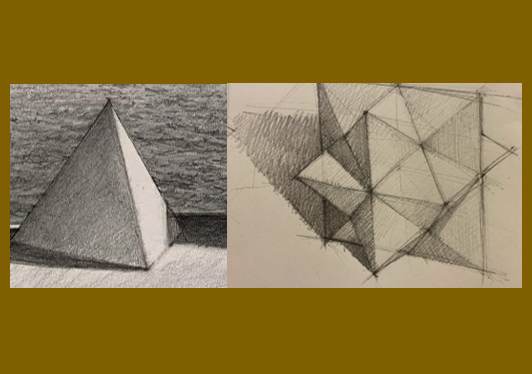
SCIENTIQUITY Expound upon the Methane molecule, which has a tetrahedral lattice, and how this relates to geometry in general, and as a possible substrate for our classical world experience. And how may this have inspired some of your art.

FOTIADIS The CH4 molecule is basically one carbon atom bonded with four hydrogen atoms in a tetrahedral configuration. I was fascinated by how this molecule is symmetrical on all sides. To me it is atomic perfection. Overlaying cubes with various angled lines, I realized that a regular tetrahedron can be created with the diagonal lines traversing the opposite faces of the cube. When I see stuff like this, I can’t help but feel that there is a broader underlying logic to how matter interacts and thus creates our reality. It is rooted in geometry, again number.
